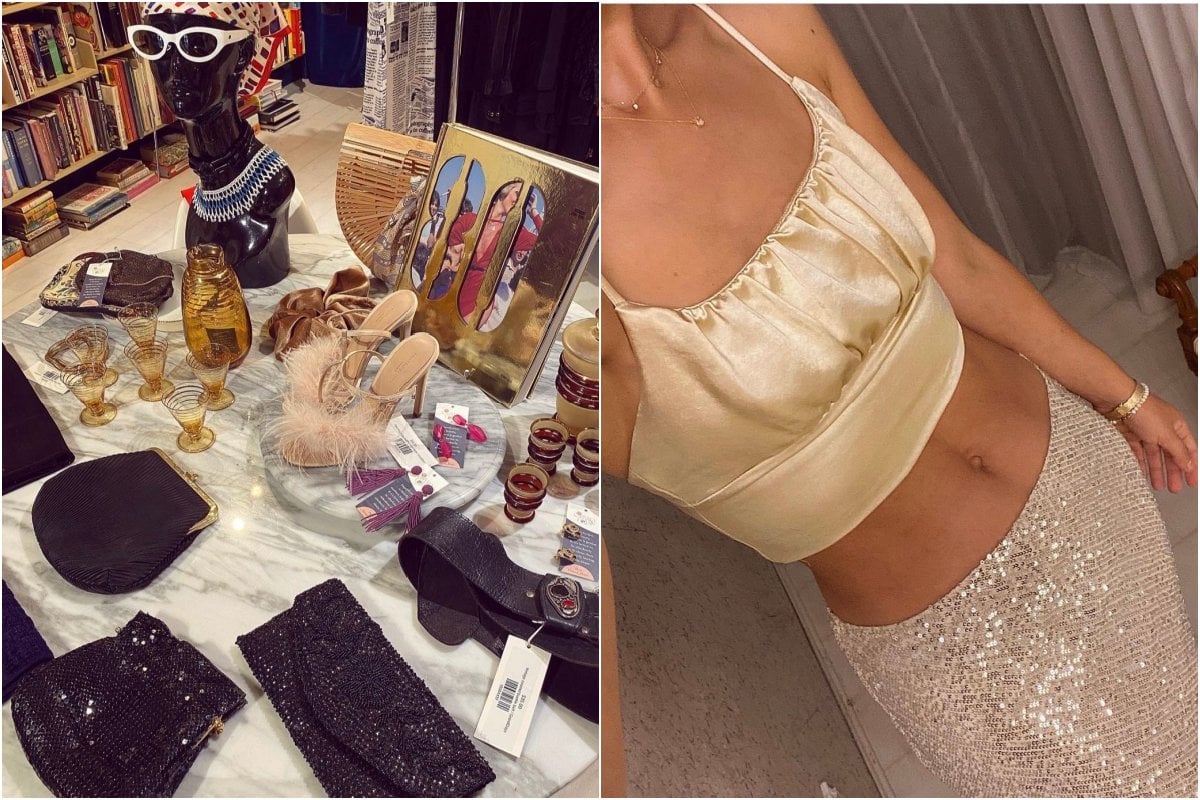Shopping Tips for Authentic Vintage Fashion is your go-to guide for exploring the timeless world of vintage clothing. This fascinating realm not only boasts unique styles and rich histories from different eras but also allows you to embrace a sustainable approach to fashion. By understanding the characteristics that define authentic vintage pieces, you’ll be better equipped to navigate the endless seas of clothing from yesteryear, finding treasures that speak to your personal style.
The journey through vintage fashion is filled with excitement as you learn to identify genuine items, discover the best shopping venues, and master the art of styling these standout pieces. With a little preparation and knowledge, you can build a wardrobe that reflects your individuality while appreciating the cultural significance behind each garment.
Understanding Vintage Fashion
Vintage fashion is more than just clothing; it’s a representation of the eras that shaped our cultural landscape. Authentic vintage pieces originate from previous decades, typically classified as being at least 20 years old. They serve as a portal to the past, reflecting the styles, materials, and social norms of their time. In a world heavily influenced by fast fashion, the allure of vintage lies in its uniqueness, craftsmanship, and often, its sustainability.Authentic vintage fashion is characterized by specific details that set it apart from contemporary styles.
High-quality fabrics, distinctive patterns, and meticulous tailoring are hallmarks of vintage garments. Designers often employed techniques that are not commonly used today, resulting in pieces that are not only visually appealing but also durable. The authenticity of vintage fashion is defined by these attributes, as well as the historical significance each item carries.
Different Eras of Vintage Fashion
Each era of vintage fashion has its own unique style, influenced by the cultural and social dynamics of the time. Understanding these eras allows enthusiasts to appreciate the diversity and evolution of fashion. Below are some key periods in vintage fashion history:
- 1920s: Known for flapper dresses, cloche hats, and a sense of liberation, this era celebrated women’s newfound independence. Iconic pieces include drop-waist dresses adorned with beads and sequins.
- 1950s: Marked by the hourglass silhouette, the 1950s featured fitted dresses, petticoats, and tailored suits. This period epitomized post-war prosperity and femininity.
- 1960s: This decade was a time of experimentation with bold patterns and colors. The mod style, characterized by mini skirts and geometric prints, emerged alongside the bohemian aesthetic.
- 1970s: Known for its laid-back vibe, the 1970s embraced bell-bottoms, maxi dresses, and a mix of textures. This decade reflected a strong sense of individual expression and cultural shifts.
- 1980s: The 1980s were marked by bold colors, oversized silhouettes, and extravagant accessories. Power suits and vibrant patterns defined this era, influenced by the rise of music icons and pop culture.
The cultural significance of vintage clothing in today’s fashion scene continues to grow, as more consumers seek sustainable and unique alternatives to mass-produced items. Vintage pieces often tell a story, connecting wearers to previous generations and offering a sense of individuality. This trend not only promotes sustainability by reducing waste but also revitalizes classic styles, making them relevant in modern wardrobes.
“Vintage fashion is the ultimate form of self-expression, allowing individuals to curate their personal style from the past.”
Identifying Authentic Vintage Pieces
When diving into the world of vintage fashion, discerning between authentic pieces and modern reproductions is crucial. The charm and character of genuine vintage garments often surpass that of their contemporary counterparts, making the hunt for true vintage a rewarding experience. Understanding the telling signs of authenticity can not only enhance your wardrobe but also enrich your appreciation for fashion history.
Authentic vintage clothing typically showcases a range of distinctive features that can be assessed through careful examination. Various methods can be employed to distinguish these timeless pieces from newer reproductions. These methods include inspecting labels, examining construction techniques, and understanding fabric types.
Methods to Distinguish Authentic Vintage
Recognizing authentic vintage pieces requires a keen eye and familiarity with several key indicators. Below are important factors that help in identifying the authenticity of garments:
- Labels: Vintage clothing often features labels from specific eras. Brands like Dior, Chanel, and Gucci are classic indicators. Knowing the typical label styles from different decades can be a valuable asset.
- Fabric Quality: Authentic vintage garments are usually made from high-quality fabrics such as silk, wool, or cotton. Modern reproductions may use synthetic alternatives that can feel different to the touch.
- Construction Details: Hand-stitched items are more likely to be vintage. Look for features like French seams, which are often a sign of quality craftsmanship.
- Style and Design: Certain cuts and designs were prevalent in specific decades, such as the A-line dresses of the 1960s or high-waisted trousers of the 70s. Familiarizing yourself with these styles can help pinpoint authenticity.
- Wear and Tear Signs: Genuine vintage items may show some signs of their history, like faded colors or small repairs, which add to their charm.
Checklist for Assessing Quality and Authenticity
Creating a checklist can be a practical step in evaluating vintage garments. This checklist can guide you through the important aspects to consider when assessing a potential purchase:
- Check the label for brand identification and era.
- Examine the fabric for quality and content.
- Inspect stitching and construction techniques.
- Look for unique design elements characteristic of the era.
- Evaluate overall condition, including any signs of repairs.
Common Labels and Brands of True Vintage
Understanding common labels and brands can significantly aid in identifying authentic vintage pieces. Many brands have stood the test of time and are highly regarded in the vintage market. Recognizing these can enhance your chances of finding genuine items:
- Levi’s: Known for their classic denim jeans, vintage Levi’s are highly sought after and often come with distinctive stitching and labels.
- Calvin Klein: The minimalist designs from the 1970s and 80s reflect a unique aesthetic that’s still celebrated today.
- Gianni Versace: Items from the late 1980s and early 1990s often feature vibrant prints and bold designs.
- Yves Saint Laurent: Vintage pieces from this designer often showcase iconic silhouettes and high-quality materials.
Being knowledgeable about vintage brands and their characteristics can significantly enhance your vintage shopping experience.
Where to Shop for Vintage Fashion

Shopping for authentic vintage fashion can be a thrilling adventure. With the rise of sustainability in fashion and a growing appreciation for unique styles, vintage clothing has become more popular than ever. Knowing where to shop is crucial for finding those hidden gems that will elevate your wardrobe. Whether you prefer the convenience of online shopping or the charm of local thrift stores, this guide will help you navigate the diverse landscape of vintage fashion shopping.
Popular Online Platforms for Purchasing Authentic Vintage Clothing
In the digital age, various online platforms offer a plethora of vintage clothing options. Here are some of the most popular ones:
- Etsy: A hub for handmade and vintage items, Etsy showcases a range of unique vintage clothing from numerous sellers worldwide.
- Depop: This mobile app caters to a younger audience, allowing users to buy and sell second-hand clothing, including a wide selection of vintage pieces.
- eBay: Known for auctions and a wide variety of products, eBay has an extensive vintage fashion section where you can find rare items.
- ThredUp: A large online thrift store that curates and resells second-hand clothing, ThredUp offers a dedicated vintage section for enthusiasts.
- ASOS Marketplace: Featuring independent boutiques, ASOS Marketplace is a great place to find curated vintage collections from around the globe.
These platforms not only provide convenience but also allow you to compare prices and styles from the comfort of your home.
Benefits of Shopping at Local Thrift Stores Versus Online Sources
While online platforms offer a vast selection, local thrift stores provide distinct advantages that can enhance your vintage shopping experience. Here are some benefits of shopping locally:
- Immediate Gratification: You can take your finds home immediately, avoiding shipping costs and waiting times.
- Unique Discoveries: Local stores often have one-of-a-kind pieces that may not be available online, allowing for more personal and diverse finds.
- Try Before You Buy: Shopping in-store allows you to try on items, ensuring the perfect fit before purchase.
- Support Local Businesses: Shopping at thrift stores often means supporting local charities or small businesses, contributing to the community.
- Treasure Hunts: The thrill of rummaging through racks and discovering unexpected treasures cannot be replicated online.
These benefits highlight the unique experience local thrift stores offer, making them an essential part of vintage shopping.
Guide on How to Navigate Vintage Markets and Fairs Successfully
Visiting vintage markets and fairs can be an exciting way to find authentic pieces. However, a little preparation goes a long way in ensuring a successful shopping experience. Here’s how to navigate these events effectively:
“The best finds come to those who are prepared.”
- Research Before You Go: Familiarize yourself with the event, the vendors attending, and the types of items typically available. This will help tailor your expectations.
- Set a Budget: Vintage items can vary widely in price; setting a budget helps avoid overspending and makes prioritizing purchases easier.
- Wear Comfortable Clothing: Since you’ll likely spend hours wandering, wear comfortable shoes and clothing to make the experience enjoyable.
- Arrive Early: Getting to the market early gives you the best chance of finding unique pieces before they are picked over.
- Inspect Items Carefully: Check for any signs of damage, such as stains or tears, and ensure the item is worth the price point.
- Don’t Hesitate: If you find something special, don’t wait. Vintage pieces can sell quickly, so if you love it, grab it!
With these tips, navigating a vintage market or fair can lead to rewarding discoveries, making your vintage fashion collection even more special.
Tips for Successful Vintage Shopping: Shopping Tips For Authentic Vintage Fashion
Vintage shopping can be a thrilling adventure, filled with unique finds and timeless treasures waiting to be uncovered. To make the most of your vintage shopping experience, it’s essential to be well-prepared and knowledgeable about the nuances of vintage pieces. This section provides key tips and tricks to ensure that you navigate the world of vintage fashion successfully.
Essential Items to Carry While Vintage Shopping
Having the right tools on hand can significantly enhance your vintage shopping experience. Here’s a list of essential items to carry:
- Measuring Tape: Vital for checking the dimensions of garments, ensuring they will fit your body type before purchasing.
- Camera: Use it to capture images of potential purchases or styles you like, which can help with comparisons and decision-making later.
- Notebook and Pen: Great for jotting down details about pieces you might want to research further or styles you want to remember.
- Reusable Bag: Handy for carrying your finds while shopping and environmentally friendly.
- Safety Pins: Useful for quick adjustments when trying on garments or if you need to secure something temporarily.
By having these items at your disposal, you can shop with confidence and ease, making sure you make informed decisions.
Importance of Trying on Clothes and Assessing Fit
Trying on vintage garments is crucial, as sizing can vary dramatically from one era to another. Unlike modern clothing, vintage pieces may not conform to today’s sizing standards, making fit assessment essential. Here’s what to focus on when trying clothes:
- Shoulder Fit: The seams should align with your shoulders. If the seams fall beyond your shoulders, the garment is likely too big.
- Waist and Hip Measurement: Ensure that you can comfortably move in the garment. It should not be too tight or too loose at the waist and hips.
- Length: Pay attention to the overall length of dresses or pants. Hemming can be done, but it’s best if the piece is close to the desired length.
- Fabric Stretch: Be mindful of how the fabric behaves when you move. Some vintage materials may have minimal stretch, impacting overall comfort.
Trying on pieces not only helps ensure a good fit but also allows you to assess the garment’s comfort and style on your body.
Negotiating Prices When Shopping at Flea Markets or Thrift Stores
Haggling is a common practice in flea markets and thrift stores, and it can lead to better deals on your vintage finds. Engaging in negotiation requires a blend of respect and savvy. Here are some tips to keep in mind:
- Research Prices: Familiarize yourself with the typical price ranges for vintage items. This knowledge will empower you during negotiations.
- Start Low: Begin your negotiation with a lower offer than what you’re willing to pay, giving you room to negotiate upwards without exceeding your budget.
- Be Polite: Approach negotiations with kindness and respect. Building rapport with sellers can often lead to better deals.
- Buy Multiple Items: If you find several pieces you love, you can leverage this by asking for a bulk discount, which may benefit both you and the seller.
Remember, negotiation is about finding a mutually beneficial price, so approach it with a positive mindset.
Caring for Vintage Clothing
Caring for vintage clothing is essential to maintain its charm and longevity. These garments often come with unique fabrics and construction techniques that require special attention. Proper care can keep your pieces looking fabulous, allowing you to enjoy them for years to come.
Cleaning Different Types of Vintage Fabrics, Shopping Tips for Authentic Vintage Fashion
When it comes to cleaning vintage clothing, it’s crucial to know the type of fabric you’re dealing with, as each requires specific cleaning methods to avoid damage. Here’s a guide on how to effectively clean various vintage fabrics:
- Silk: Hand wash silk items in cold water using a gentle detergent. Avoid wringing or twisting the fabric. Lay it flat on a clean towel to dry, then hang it up to finish drying.
- Wool: For wool garments, use a mild detergent and cold water. Gently press the water out without agitating the fabric. Always dry flat to maintain shape.
- Cotton: Cotton is more durable and can usually be machine washed on a gentle cycle. Use cold water and air dry to prevent shrinkage.
- Lace: Hand wash lace in cold water with a delicate detergent, then lay it flat to dry. Avoid any twisting or wringing to keep the lace intact.
- Denim: Vintage denim can often withstand machine washing, but it’s best to wash inside-out in cold water. Hang dry to maintain the fabric’s integrity.
Best Storage Practices for Vintage Pieces
Proper storage is vital for preserving vintage clothing and preventing deterioration. Here are essential tips on how to store your pieces safely:
- Use Acid-Free Storage: Store garments in acid-free tissue paper or boxes to prevent yellowing and degradation.
- Avoid Hangers: Use padded hangers for dresses and tops, but avoid hanging heavy items such as coats, which can stretch out the fabric.
- Climate Control: Keep garments in a cool, dark, and dry location. High humidity can encourage mold growth, while excessive heat can cause fabrics to degrade.
- Rotate Items: If you have a large collection, rotate your items every few months to avoid prolonged pressure on any one piece.
- Protect from Light: Avoid direct sunlight as it can cause fading. Storage in a dark area or covering items with breathable fabric can help.
Repairing or Altering Vintage Garments
When it comes to repairs or alterations, preserving the integrity of vintage garments is paramount. Here are some tips to keep in mind:
- Small Repairs: For minor tears, a simple hand-stitch can often suffice. Use thread that matches the fabric color and texture.
- Replacing Buttons: Use vintage or similar style buttons to maintain the garment’s original aesthetic. This can often enhance the piece rather than detract from it.
- Altering Fit: If adjustments are necessary, opt for side seams and darts rather than altering the main seams. This keeps the original structure intact.
- Professional Help: For major alterations or if you’re unsure, consult a professional who specializes in vintage clothing. Their expertise can prevent irreversible damage.
- Patchwork Techniques: Incorporating patches can add character to worn items, especially in denim or cotton. Choose patches that complement the vintage style.
Remember, vintage clothing is often irreplaceable; treating it with care ensures it can be enjoyed for generations.
Styling Vintage Fashion
Vintage fashion is more than just a trend; it’s a statement that merges history with personal style. Integrating vintage pieces into your modern wardrobe can create unique outfits that exude character and individuality. By thoughtfully combining these timeless items with contemporary pieces, you can achieve a balanced and stylish look that reflects your personal flair.
Outfit Ideas Incorporating Vintage Pieces
When styling vintage fashion, consider experimenting with layering and accessorizing to create outfits that resonate with your unique style. Here are some outfit ideas that seamlessly incorporate vintage pieces:
- Vintage Blazer with Modern Jeans: Pair a structured vintage blazer with high-waisted jeans for a chic yet relaxed look. This combination works well for both casual outings and more polished events.
- A-Line Skirt with a Graphic Tee: Combine a classic A-line vintage skirt with a modern graphic tee to create a playful look that juxtaposes classic and contemporary styles.
- Retro Dress with Sneakers: Wear a vintage dress from the 70s with trendy sneakers for an effortlessly cool vibe. This mix of dressy and casual elements creates a striking balance.
- Vintage Accessories with Everyday Outfits: Incorporate vintage jewelry, handbags, or scarves into your daily attire to add a touch of nostalgia without overwhelming your look.
Mixing Vintage Items with Contemporary Fashion
Successfully blending vintage and contemporary pieces requires attention to detail and an understanding of proportion and color. Here are some tips to help you master this art:
- Color Coordination: Choose a color palette that harmonizes both vintage and modern items. For instance, if your vintage piece has bold colors, keep the contemporary items neutral to let the vintage piece stand out.
- Proportional Balance: Balance looser vintage pieces with fitted modern clothing. For example, if you wear an oversized vintage coat, pair it with slim-fit pants to maintain a flattering silhouette.
- Layering Techniques: Layer vintage and contemporary items to create depth. A vintage vest can be layered over a modern button-up shirt for an interesting and stylish texture.
- Accessorizing Wisely: Use modern accessories to elevate vintage pieces. A contemporary belt can cinch a vintage dress, providing shape and a fresh touch.
Current Trends in Vintage Fashion
Several vintage trends have resurfaced in recent years, allowing fashion enthusiasts to incorporate retro styles into their modern wardrobes. Here’s how to adapt these trends today:
- Floral Prints: Floral patterns from the 90s are making a comeback. Incorporate them through dresses or blouses and pair them with solid-color bottoms for a fresh take.
- High-Waisted Bottoms: High-waisted trousers and skirts are versatile pieces that can be paired with cropped tops or tucked-in blouses for a vintage-inspired silhouette.
- Chunky Knitwear: Oversized sweaters from the 80s can be styled with skinny jeans or layered over dresses for a cozy, vintage vibe.
- Statement Coats: Look for bold vintage coats to make a statement. These can elevate simple outfits and serve as the focal point of your ensemble.
The Sustainability Aspect of Vintage Shopping
Vintage shopping offers more than just unique fashion finds; it also plays a significant role in promoting sustainable practices within the fashion industry. By choosing vintage clothing, consumers can reduce their environmental footprint and contribute to a more sustainable future. This section highlights the environmental benefits of opting for vintage over fast fashion, the positive impact on sustainable fashion practices, and relevant statistics illustrating how vintage shopping helps mitigate waste.
Environmental Benefits of Choosing Vintage Fashion
Unlike fast fashion, which encourages a cycle of overproduction and waste, vintage shopping supports the concept of reusing and recycling clothing. By purchasing second-hand pieces, individuals can help extend the lifecycle of garments, reducing the demand for new production, which is resource-intensive.
- Reduction of Textile Waste: The fashion industry is responsible for a staggering amount of waste. According to the Environmental Protection Agency (EPA), approximately 11.3 million tons of textile waste were generated in the U.S. alone in 2018. By opting for vintage clothing, consumers can divert these items from landfills.
- Conservation of Resources: Producing new clothing requires significant resources, including water and energy. It is estimated that producing a single cotton t-shirt can consume up to 2,700 liters of water. Vintage fashion reduces the need for new resources by promoting the use of pre-existing clothing.
- Lower Carbon Footprint: The carbon emissions associated with manufacturing new clothing are considerable. A study by the UN Environment Program suggests that the fashion industry contributes to about 10% of global carbon emissions. Vintage shopping helps to minimize this impact by reducing the demand for new items.
Contribution to Sustainable Fashion Practices
Purchasing vintage clothing not only helps reduce waste but also supports sustainable fashion practices. By choosing vintage, consumers actively participate in a more circular economy that values longevity and ethical consumption.
- Promotion of Ethical Sourcing: Vintage stores often curate their selections with care, focusing on quality over quantity. This encourages consumers to invest in well-made pieces that will last longer, aligning with sustainable fashion principles.
- Support for Small Businesses: Many vintage shops are independently owned and operated. Shopping at these establishments helps sustain local economies while promoting responsible business practices that prioritize environmental sustainability.
- Encouragement of Individuality: Vintage fashion fosters a unique style that encourages consumers to express themselves without conforming to fast fashion trends. This shift away from mass-produced items supports the idea of mindful consumption.
Statistics on Vintage Shopping and Waste Reduction
The impact of vintage shopping on waste reduction is significant and quantifiable. By choosing vintage, individuals can make a tangible difference in the fashion industry’s environmental footprint.
“Each year, the average American throws away around 81 pounds of clothing, much of which could be reused or recycled.”
- Waste Diversion: The Bureau of International Recycling reports that the global recycling rate for textiles is only around 15%. Vintage shopping can help increase this number by promoting the reuse of clothing.
- Impact on Carbon Footprint: A report by WRAP (Waste and Resources Action Programme) found that if every person in the UK bought just one vintage item instead of a new one, it would save about 1.5 million tons of CO2 emissions annually.
- Extended Garment Lifespan: Research indicates that extending the life of a garment by just nine months can reduce its environmental impact by 20-30% in terms of carbon, water, and waste footprints.



